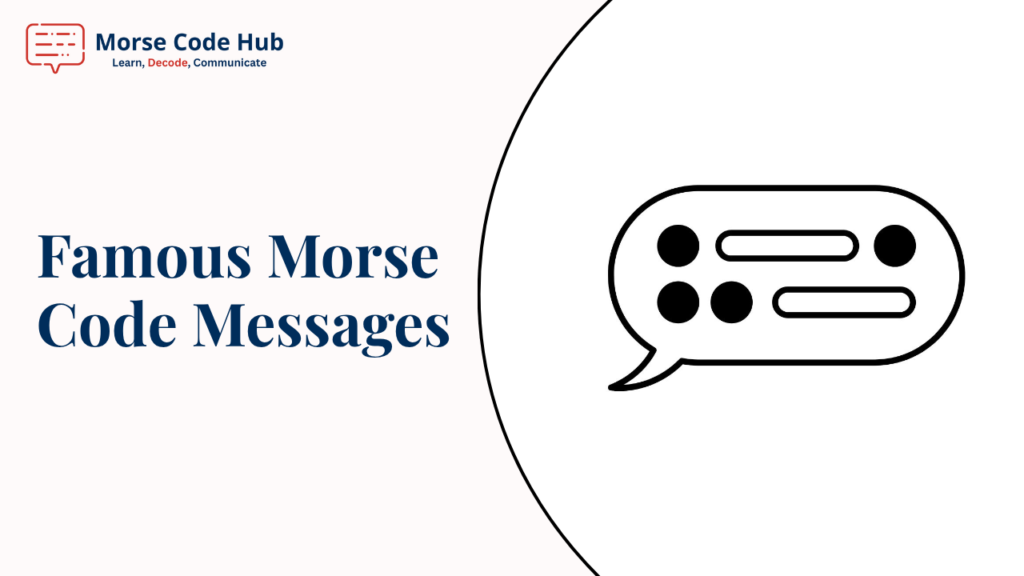Famous Morse code messages have left an indelible mark on history, from the first telegraph transmission to covert signals in wartime and subtle nods in pop culture. These sequences of dots and dashes carried urgent pleas, secret intelligence, and even artistic flair, proving Morse code’s power to convey critical information across barriers. As a Morse code enthusiast, I’ve explored the stories behind these iconic messages, blending historical depth with their enduring legacy. This article dives into six pivotal moments that highlight Morse code’s impact, and with tools like those on Morse Code Hub, you can decode these messages in languages from Latin to Japanese.
The First Ever Morse Code Message: “What Hath God Wrought”
On May 24, 1844, Samuel F.B. Morse sent the first commercial telegraph message from Washington, D.C., to Baltimore, Maryland, a distance of 38 miles. The message, “What Hath God Wrought” (Numbers 23:23), suggested by Annie Ellsworth, daughter of the patent commissioner, marked a turning point in communication. By 1861, the Pony Express ceased, unable to compete with the telegraph’s speed.
This biblical phrase, encoded as •••• • / •– / – / •••– • / –– / •••– / •– / ••– / ••• / •••• / – (WHAT HATH GOD WROUGHT), was chosen for its reverence, reflecting the era’s view of technology as divine progress. Morse’s invention shrank distances, enabling commerce and diplomacy. Try encoding this historic message with our Morse code translator to feel its groundbreaking rhythm.
Titanic’s Distress Call: The SOS That Shook the World
On April 14, 1912, the RMS Titanic struck an iceberg, and its Morse code distress calls became one of history’s most famous. Operators Jack Phillips and Harold Bride sent CQD (–•–• ––• –••), the Marconi distress signal, before switching to the newer SOS (••• ––– •••). According to World History Edu, it notes that the Carpathia, 58 miles away, received the SOS and rescued 705 survivors, though 1,514 perished. The Titanic’s signals were critical, with 90% of ships using Morse code for distress by 1910.
The SOS, chosen in 1906 for its simplicity (three dots, three dashes, three dots), cut through radio clutter, unlike the complex CQD. The tragedy underscored Morse code’s life-saving role, cementing SOS as a universal plea. Decode SOS or CQD with our words in Morse code tool to hear their urgency.
Jeremiah Denton's Blinked Message: A Silent Cry for Help
In 1966, U.S. Navy pilot Jeremiah Denton, a prisoner of war in North Vietnam, used Morse code to expose his captors’ brutality. During a televised propaganda interview, Denton blinked “T-O-R-T-U-R-E” (– / ––– / •–• / – / ••– / •–• / •) while feigning light sensitivity. U.S. Naval Intelligence decoded the message, confirming POW torture for the first time. Denton’s act, during nearly eight years of captivity, became a symbol of resilience.
Denton’s use of eye blinks—transmitting Morse without sound—showcased its versatility. Morse code’s adaptability, requiring only 100–150 Hz bandwidth, makes it ideal for covert signaling. Encode “TORTURE” with our numbers in Morse code tool to grasp Denton’s courage.
World War II Signals: Secret Communications from the Front
During World War II, Morse code was the backbone of military communication, enabling secure and rapid messaging. U.S. military sent over 1 million Morse code messages, coordinating strategies across theaters Military.com. Signal lamps and radios transmitted coded orders, with operators achieving speeds up to 84 words per minute, compared to an average of 30–35, as per Military.com.
One notable use was by Native American code talkers, who combined Morse code with Navajo and other languages to thwart Axis interception. The British also relied on Morse at Bletchley Park, where over 10,000 German messages were decoded daily by 1944. During D-Day, Morse signals coordinated landings, with 70% of Allied naval communications using it. These secret transmissions shaped victories, proving Morse’s strategic value. Try encoding wartime terms like “VICTORY” with our Morse code translator.
Morse in Pop Culture: Hidden Messages in Music and Movies
Morse code has woven itself into pop culture, embedding secret messages in music and films. In 2010, the Colombian Army hid a Morse code message in a pop song, “Better Days,” broadcast to hostages held by FARC guerrillas. The code spelled “19 PEOPLE RESCUED. YOU ARE NEXT. DON’T LOSE HOPE,” boosting morale, with 80% of hostages hearing it, as per RECOIL OffGrid. This creative use showed Morse’s modern relevance.
In music, Rush’s “YYZ” (–•–– –•–– –••) uses Morse code for Toronto’s airport identifier to craft its rhythm. In films like Interstellar (2014), “STAY” (••• – •– –––) is decoded from falling books, as per Daily Dabble. These examples highlight Morse’s cultural staying power. Encode pop culture phrases like “MUSIC” with our numbers in the Morse code tool.
Conclusion
Famous Morse code messages, from “What Hath God Wrought” to the Titanic’s SOS, Jeremiah Denton’s blinked “TORTURE,” and WWII’s 1 million signals, have shaped history and culture. By 1870, 650,000 miles of telegraph lines carried these messages, and by 1910, 90% of ships relied on Morse for safety. From Apollo 11 to pop songs, Morse code’s versatility endures. Explore these iconic messages with Morse Code Hub tools and tap into the legacy of dots and dashes in 2025.



